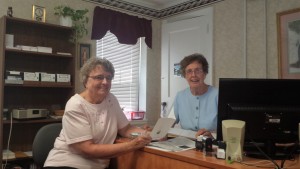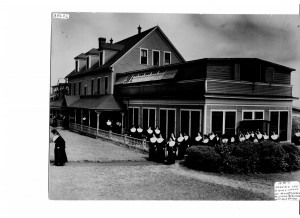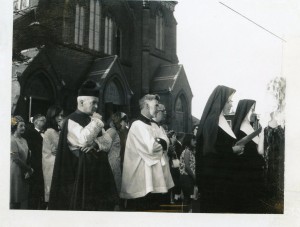WESTFIELD–As the ages rise for members of Sisters of St. Joseph of Springfield and their membership numbers decrease, the congregation faces a long financial crisis.
Sisters of St. Joseph, whose members provided education at the St. Mary’s schools in Westfield for over 100 years, is facing an $8 million need in order to continue to provide housing, food and medical care for retired Sisters. While the number is down from the $40 million originally forecast, the gap is still very large and the group has been asking for help from the communities they served. The congregation is currently seeking $1.5 million in fundraising to reach their goal.

On left, Sister Mary Ferguson, who was the last teacher at St. Mary’s, and Sister Connie Quinlan, former principal of St. Mary’s.
“We’re reaching out to those we helped for so many years to now help us,” Sister Connie Quinlan said.
Quinlan, who is also the former principal of both St. Mary’s elementary and high schools, said that the group has been dedicated to many communities since 1898 and did not think of finances when they did their selfless work.
“We didn’t think anything of it because we thought people would keep coming in,” Quinlan said.
She and others assumed that the congregation would keep attracting members. These new members would work and then put their earnings back into the congregation. This was common practice for most congregations, whether they taught in Catholic schools or were nurses in medical facilities. The common goal was to provide for the community first, then survive with whatever was received after.
However, like most other congregations in the rest of the US beginning in the 1970s, the sisters found that their membership numbers kept declining. To put the severity of the lack of membership into perspective, according to the congregation just one new member has joined, or “profess her first vows,” within the past several years.
“Young people I feel are finding new and different ways to serve, such as the Peace Corps and international missions,” Quinlan said.
Additionally, the Catholic schools that they were often in charge of had staffing issues due to less members, so outside teachers were hired at the cost of the congregations. This meant paying them more, which dwindled their money even further.
“From the ’70’s on, every group saw the realities of our finances and worked very hard to fix it,” Sister Mary Schneider said.
While continuing to teach in the schools, the congregation sought new ways to both provide for the community and to attempt to make some money to survive, so they opened Montmarie Nursing Home in Holyoke in the early 1990s, Schneider said.
Montmarie was originally the congregation’s central office, or “motherhouse,” as well as housing for their retired and infirmed members. Schneider said that at the time the declining population meant that less space was needed, and Montmarie was too large for the group. Also, the operating costs, in spite of the dwindling population, stayed the same. So, for these two reasons they converted the complex into a nursing home and welcomed new patients.
However, the plan was only partially effective. Problems arose due to many of their patients being on Medicare or Medicaid, and under those plans the state and federal governments will only pay partially for health costs. The rest of the costs then go unpaid, leaving the nursing home with less money than expected.
So, in order to alleviate the still-growing debt, the group decided to sell Montmarie in 2014, and moved the sisters who were living there that needed care to nearby congregations in Boston.
“Our whole community together affirmed the decision to the very last vote,” Schneider said. “We did it together.”
The sale cut the deficit from $40 million to $8 million, not just because of the money from the acquisition but also because of the lack of money needed to keep Montmarie running.
Still, the group needs more money and are working hard to earn it so they can keep going. They have been doing fundraising work, including the “Support the Sisters” campaign that does a number of events in the area.
Members are also still working if they can, in spite of the fact that only four of the 209 sisters are under the age of 65.
“We have a sister turning 90 next April and she’s working for pay doing light carpentry work,” Schneider said.
Others are continuing to do charity work regardless of their age, as long as they are physically able.
“It’s like you don’t retire,” Quinlan said.
Overall, the congregation has been steadfast in their hope, in spite of the large economic hurdle they face.
“We’re feeling optimistic–very optimistic–that we’re going to make our financial goal,” Schneider said.
And for the women, it isn’t about the money in the end.
“I can’t begin to tell you what spirited women we have,” Schneider said. “We have good health and that’s a blessing.”
If you would like to donate you can visit time2support.org and donate online, or find out where the Sisters of St. Joseph’s next fundraising event is being held.




